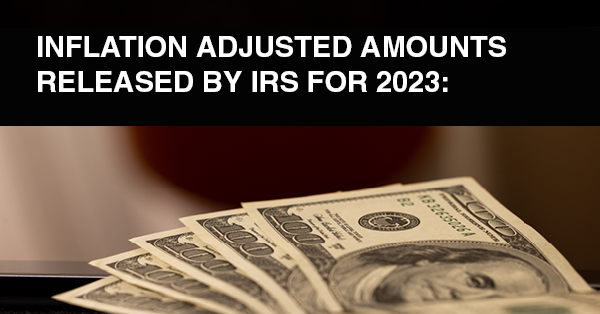INFLATION ADJUSTED AMOUNTS RELEASED BY IRS FOR 2023:

Check out the schedule of the NSTP Federal Tax Update and Review Courses for all the information you will need to prepare 2022 tax returns and get ready for the 2023 tax year..
The IRS has released Revenue Procedure 2022-38 that contains most of the inflation adjusted numbers to be used when helping your clients prepare for their 2023 taxes.
As the numbers relate to the law as it existed at the date of publication of the procedure, something that could change based on pending Congressional action, the procedure contains the following warning:
This revenue procedure sets forth inflation-adjusted items for 2023 for various Code provisions as in effect on October 18, 2022. The inflation adjusted items for the Code sections set forth in section 3 of this revenue procedure are generally determined by reference to § 1(f) of the Code. To the extent amendments to the Code are enacted for 2023 after October 18, 2022, taxpayers should consult additional guidance to determine whether these adjustments remain applicable for 2023.
Following are selected items in the Rev. Proc.:
Standard Deduction.
(1) In general. For taxable years beginning in 2023, the standard deduction amounts under § 63(c)(2) are as follows:
| Filing Status | Standard Deduction |
|---|---|
|
Married Individuals Filing Joint Returns and Surviving Spouses (§ 1(j)(2)(A)) |
$27,700 |
| Heads of Households (§ 1(j)(2)(B)) |
$20,800 |
| Unmarried Individuals (other than Surviving Spouses and Heads of Households) (§ 1(j)(2)(C)) | $13,850 |
| Married Individuals Filing Separate Returns (§ 1(j)(2)(D)) | $13,850 |
Earned Income Credit.
(1) In general. For taxable years beginning in 2023, the following amounts are used to determine the earned income credit under § 32(b). The “earned income amount” is the amount of earned income at or above which the maximum amount of the earned income credit is allowed. The “threshold phaseout amount” is the amount of adjusted gross income (or, if greater, earned income) above which the maximum amount of the credit begins to phase out. The “completed phaseout amount” is the amount of adjusted gross income (or, if greater, earned income) at or above which no credit is allowed. The threshold phaseout amounts and the completed phaseout amounts shown in the table below for married taxpayers filing a joint return include the increase provided in § 32(b)(2)(B), as adjusted for inflation for taxable years beginning in 2023. The threshold phaseout amounts and the completed phaseout amounts shown in the table below for single, surviving spouse, or head of household taxpayers also apply to married taxpayers who are not filing a joint return and satisfy the special rules for separated spouses in § 32(d).
|
Number of Qualifying Children |
||||
|---|---|---|---|---|
|
Item |
One | Two | Three or more | None |
| Earned Income Amount | $11,750 | $16,510 | $16,510& | $7,840 |
| Maximum Amount of Credit | $3,995 | $6,604 | $7,430 | $600 |
|
Threshold Phaseout Amount (Single, Surviving Spouse, or Head of Household) |
$21,560 | $21,560 | $21,560& | $9,800 |
| Completed Phaseout Amount
(Single, Surviving Spouse, or Head of Household) |
$46,560 | $52,918 | $56,838 | $17,640 |
|
Threshold Phaseout Amount (Married Filing Jointly) |
$28,120 | $28,120 | $28,120 | $16,370 |
|
Completed Phaseout Amount (Married Filing Jointly) |
$53,120 | $59,478 | $63,398 | $24,210 |
For taxable years beginning in 2023, the earned income tax credit is not allowed under § 32(i) if the aggregate amount of certain investment income exceeds $11,000.
Annual Exclusion for Gifts.
(1) For calendar year 2023, the first $17,000 of gifts to any person (other than gifts of future interests in property) are not included in the total amount of taxable gifts under § 2503 made during that year.
(2) For calendar year 2023, the first $175,000 of gifts to a spouse who is not a citizen of the United States (other than gifts of future interests in property) are not included in the total amount of taxable gifts under §§ 2503 and 2523(i)(2) made during that year.




